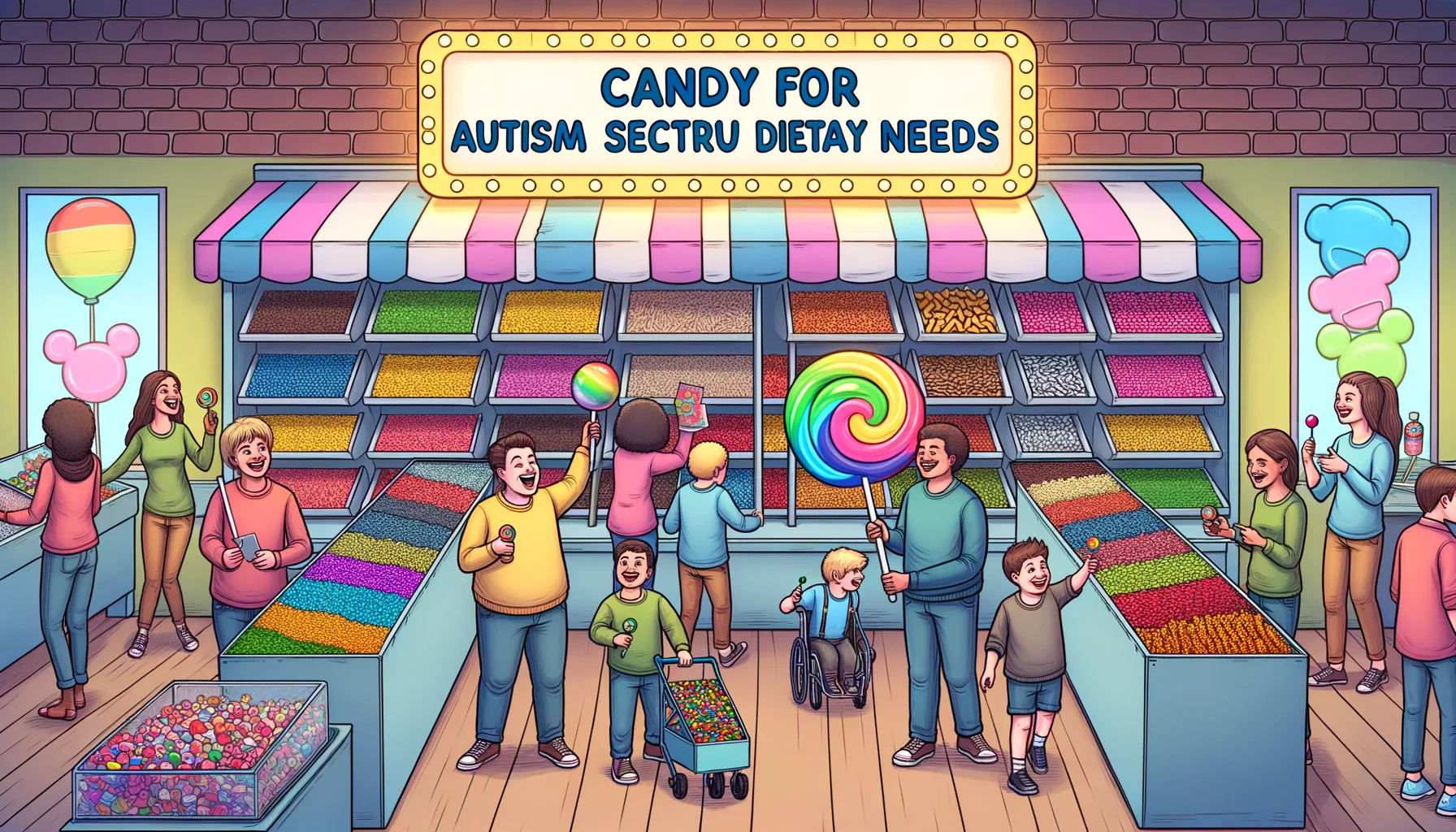Candy for Autism Spectrum Dietary Needs Quiz
Test Your Knowledge
Question of
Understanding Autism Spectrum Dietary Needs
When I first delved into the world of autism spectrum dietary needs, it was like stepping into a kitchen where every ingredient mattered and each flavor had to be carefully considered. It's a dance of nutrition, taste, and well-being that could either be a harmonious ballet or a tumultuous tango. For individuals on the autism spectrum, certain foods can affect not just their body but also their sensory experiences and behaviors, making mealtime a pivotal part of their daily routine.
I remember the time when my friend's child, who is on the spectrum, came over for dinner. We had prepared a feast, but soon realized that our menu was far from suitable. That day we learned about the importance of understanding dietary restrictions and how they can significantly impact the lives of those with autism. It was an enlightening moment that transformed our perspective on food and inclusivity.
Indeed, diving into this aspect of dietary needs is not just about substituting ingredients; it's about embracing a lifestyle that supports wellness and happiness. It's an exploration of textures and flavors that can comfort, excite, or soothe. And its about finding joy in the little victories, like discovering a new snack that is both delicious and compliant with dietary restrictions.
Identifying Common Dietary Restrictions
The culinary journey for those with autism often starts with identifying which common dietary restrictions need to be adhered to. Gluten-free options have become synonymous with this exploration as gluten can sometimes lead to discomfort or adverse reactions. But it's not just about avoiding wheat - it's about reinventing classics so that no one feels left out during dessert time.
Casein-free treats are another avenue in this diverse landscape. Casein, a protein found in milk, is often excluded from the diets of those on the spectrum due to its potential effects on digestion and behavior. The challenge here is crafting sweets that still deliver creaminess and delight without relying on traditional dairy products a task that once seemed daunting but now sparks creativity in kitchens everywhere.
- Gluten-Free Options: A world where rice flour and almond meal become your best friends.
- Casein-Free Treats: Exploring coconut milk and other plant-based alternatives for that creamy texture.
Nutritional Considerations for Autism
Incorporating omega-3 fatty acids into the diet is like weaving threads of gold into a tapestry; they're essential for brain health and cognitive function. I've seen how adding a sprinkle of chia seeds or a dash of flaxseed oil to homemade candy can enrich not only its nutritional profile but also its taste.
Vitamins and minerals also play leading roles in this narrative. Magnesium for relaxation, zinc for immune support each nutrient has its part to play in supporting overall health. And let's not forget about fiber! Ensuring adequate fiber intake through snacks can be both fun and beneficial think high-fiber gummies shaped like stars or moons, sparking joy with every chew.
The role of vitamins and minerals extends beyond mere sustenance; they act as supporting characters in the story of well-being. With every mindful bite comes an opportunity for empowerment an empowering message wrapped in the sweet embrace of healthy treats.
Allergies and Sensitivities
Recognizing allergic reactions is akin to being a detective observing, taking notes, and always being ready to respond. The slightest hint of cross-contamination can unravel hours of careful preparation, turning what should be a delightful experience into one fraught with anxiety.
To navigate this terrain effectively requires vigilance and understanding knowing which signs to look for when an allergic reaction might be underway (such as hives or difficulty breathing), and how best to manage environments to minimize risks. This knowledge becomes as crucial as any recipe when cooking up confections for sensitive individuals.
Cross-contamination is no laughing matter; it demands respect and meticulousness in equal measure. It means double-checking labels, cleaning surfaces with precision, and always being aware that even a trace amount can have significant consequences. Through this lens, making candy isn't just an act of indulgence; its an act of love and commitment to safety.
Selecting Safe Candy Ingredients
Embarking on the quest for the perfect sweet treat, especially when catering to dietary needs associated with the autism spectrum, is like setting sail on a serene ocean with hidden depths. The waters of candy ingredients are vast and varied, and it's essential to navigate them with care. I remember the first time I had to scrutinize labels at the grocery store; I felt like an intrepid explorer, albeit one armed with a magnifying glass rather than a sword.
The sensory experience of enjoying candy is a universal delight. The bright colors that catch your eye, the rustling of wrappers that sets anticipation tingling, and finally, the flavors that dance upon the tongueall are part of this simple joy. But for those on the autism spectrum, certain ingredients can disrupt this blissful indulgence. It's not just about tasteit's about how these components interact with our unique systems.
Through trial and error, I've learned that selecting safe candy ingredients isn't just about reading labels; it's about understanding what goes into our bodies and how it affects us. It's about being mindful and making choices that allow everyone to partake in the sweetness of life without worry or compromise.
Natural vs. Artificial Flavors
There's something inherently comforting about natural flavors. Maybe it's because they whisper tales of orchards and sun-drenched fields in their taste, or perhaps it's because our bodies seem to recognize them as old friends. When I first discovered that natural flavorings could be extracted from fruits, spices, plants, or even meats, my culinary horizons expanded exponentially.
Benefits of Natural Flavorings
I can't help but feel a little thrill each time I find a candy that boasts natural flavorings. There's a sense of purity therea promise that what I'm about to enjoy is rooted in nature's bounty rather than concocted in a lab. These treats often have subtler, more complex profiles that echo the real essence of their ingredients. And for many individuals on the autism spectrum who may be sensitive to strong stimuli, this gentleness can make all the difference.
Risks of Artificial Additives
Meanwhile, artificial additives often come with their own lore of cautionary tales. They're like the mysterious potions in storiespotent and unpredictable. Some studies suggest they might affect behavior or exacerbate symptoms in people with sensory sensitivities. Whenever I bypass candies laced with artificial flavors in favor of their natural counterparts, it feels like choosing authenticity over illusiona small but significant act of self-care.
Coloring and Preservatives
The allure of brightly colored candies can be strongthey're like jewels beckoning from behind the glass display. But as I've learned more about what goes into those vibrant hues, my enchantment has waned. It turns out that some artificial colors are akin to unwanted guests at a party: they might look interesting but can cause quite a stir.
Healthier Alternatives to Artificial Colors
-
Beet juice concentrate: A blush of pink or red that brings warmth without worry.
-
Turmeric: This golden spice offers more than just colorit whispers ancient secrets of health.
-
Spirulina extract: A touch of green derived from algae might sound peculiar until you realize it's nature's own paintbrush.
Understanding Preservative-Free Labels
I've become quite the detective when it comes to preservative-free labels, peering closely at ingredient lists as if they're maps to hidden treasure. It's empowering to choose candies free from chemical preservativeslike saying no to unnecessary baggage on our journey through life. And for those who tread this path while navigating dietary restrictions related to autism, this vigilance is not just empowering; it's essential.
Sweeteners and Sugar Substitutes
A sweet tooth can be insistentsometimes it feels like a siren call luring me towards shelves stocked with sugary confections. Yet amidst this sea of sweetness lies a spectrum ranging from naturally sourced sugars to synthetic substitutes that may seem benign but carry their own set of complexities.
Exploring Natural Sweeteners
Natural sweeteners are like finding an oasis in a desertthey quench your thirst without leaving you wanting more. Honey drizzled over homemade treats or maple syrup pooled in golden puddles atop pancakes; these are tastes tied directly to natures apron strings. In candies designed for those on the autism spectrum with dietary considerations, natural sweeteners offer flavor without overstimulationa gentle nod towards moderation and balance.
Avoiding High-Fructose Corn Syrup
Awareness is key when avoiding high-fructose corn syrup (HFCS). Like an imposter posing as royalty among sugars, HFCS often hides in plain sight within ingredient listsubiquitous yet inconspicuous. Its prevalence is matched only by concerns over its potential health impacts, including its role in inflammationan unwelcome guest for anyone but particularly so for those with dietary sensitivities associated with autism.
The Best Candy Options for Autism Spectrum
Embarking on a sensory adventure often involves more than just sight and sound, especially when it comes to the vibrant world of candy. For those on the autism spectrum, this adventure can be both delightful and challenging. The allure of a sweet treat is universal, yet the dietary needs can be quite specific. As someone who has navigated these waters, I can attest to the joy that finding the right candy can bring. Its not just about satisfying a sweet tooth; its about discovering treats that harmonize with our unique needs.
Let me take you through an exploration of confectionery delights that are as considerate as they are captivating. Whether you're seeking organic bliss or vegan wonders, there's something here to tickle your taste buds while honoring your health and well-being.
Organic Candy Choices
When it comes to sweets, going organic feels like giving a loving hug to both your body and Mother Earth. Organic candies are crafted with ingredients that sing the song of natural purity, free from synthetic pesticides and artificial fertilizers. They're a choice that resonates with my core values, offering peace of mind with every delectable bite.
Finding candies that bear the badge of organic certification is akin to embarking on a treasure huntthrilling and rewarding. Each discovery is a promise of quality and authenticity, ensuring that what melts in your mouth is nothing but nature's best.
Advantages of Organic Ingredients
Indulging in organic candy is like whispering sweet nothings to your bodythere's an inherent goodness that can't be denied. The advantages? Think fewer chemicals and more nutrient-rich bites. It's the difference between a symphony played by an orchestra versus a single instrumentit's richer, fuller, and infinitely more satisfying.
And let's not forget the environmental love story here. By choosing organic candies, we're supporting farming practices that nourish the soil rather than deplete ita small act with ripple effects that extend far beyond our own enjoyment.
Finding Certified Organic Candies
To find these gems in the vast sea of sweets, look for labels adorned with certified organic sealsa beacon signaling safe harbor in our quest for purity. These certifications are not mere decorations; they are assurances from rigorous testing and standards set by trusted organizations.
Here's a little secret: sometimes these treasures are hidden in plain sight at local farmers' markets or tucked away on specialty store shelves. And let me tell you, when you do find them, it feels like stumbling upon buried goldonly sweeter.
Non-GMO Candy Selections
In my journey through the kaleidoscope of candies available today, I've developed a keen eye for those marked with the non-GMO labela signpost pointing towards natural genetic integrity. There's something inherently comforting about knowing your treats haven't been tampered with at their core.
The landscape of non-GMO sweets is varied and vibrant; from gummy bears bursting with fruitiness to dark chocolate squares whispering tales of cocoa fields untouched by genetic modification. Each one offers its own unique flavor narrative while respecting our body's need for untainted ingredients.
Understanding Non-GMO Labels
To navigate this non-GMO terrain with confidence, one must become versed in reading labelsits like learning a new language where symbols speak louder than words. These labels act as trusty guides ensuring we don't stray from our path towards wholesome indulgence.
Becoming fluent in this labeling lingo has opened up new realms of candy possibilities for meone where I can savor each morsel knowing it aligns with my dietary choices and ethical stance.
Health Implications of GMOs
The debate around GMOs is as tangled as licorice twistswith opinions ranging from staunch opposition to hearty endorsement. From my perspective, opting for non-GMO candies isn't just about personal health; its about participating in a larger conversation regarding food safety and biodiversity.
- The precautionary principle whispers caution into our choices,
- Suggesting we may be better off erring on the side of natures original recipes,
- Rather than embracing modifications whose long-term impacts remain shrouded in mystery.
Vegan-Friendly Candies
A canvas painted with plant-based colors offers an inclusive palette where all can find their shade of sweetnessthat's what vegan-friendly candies represent to me. These confections break free from animal-derived shackles, allowing pure plant power to shine through in every sugary creation.
I've found joy in unearthing these compassionate concoctions; each one feels like an affirmation of lifes interconnectednessa reminder that indulgence doesnt have to come at anothers expense.
Benefits of Plant-Based Candies
The benefits of plant-based candies stretch beyond their cruelty-free ethosthey're often packed with unexpected nutritional perks too! Imagine biting into a piece of candy and receiving not just an explosion of flavor but also a dose of kindness towards all beingsthat's something truly worth savoring.
In this realm where fruits and nuts dance together in sweet harmony, we discover treats that offer more than momentary pleasurethey provide sustenance for both body and soul.
Identifying Vegan Candies
Distinguishing vegan candies amidst their counterparts requires a keen eyelabels become puzzles waiting to be solved by discerning detectives like us. But once you know what to look for (think beeswax-free glazes and gelatin alternatives), these delights become less elusivea testament to plant-based innovation shining through every chew or crunch.
In sharing my encounters with these guilt-free goodies, I hope to inspire others on similar questsbecause when it comes down to it, isnt life just sweeter when shared?
Homemade Candy Alternatives
Easy Recipes for Homemade Treats
Have you ever felt the rush of excitement as you mix and match ingredients, creating something delectable that dances on your taste buds? That's the magic of whipping up homemade candy. For those seeking to cater to Autism Spectrum dietary needs , this becomes more than just a pastime; it's a heartfelt journey into the world of tailor-made sweets. The beauty of easy recipes lies in their simplicityfewer components but a whole lot of love. I remember the first time I tried my hand at making chewy fruit drops with natural flavors, free from artificial colors. The vibrant hues came from pureed fruits and veggies, and the taste was as authentic as laughter on a sunny day.
Even the most novice of chefs can revel in no-bake optionsimagine crafting peanut butter balls with just a handful of ingredients or shaping malleable date and nut bars that require zero oven time. The sheer joy of watching these treats come together, without the intimidation of baking, is akin to finding hidden treasures in your own kitchen.
- Simple Ingredient Swaps: Use honey or maple syrup in place of refined sugars.
- No-Bake Candy Options: Create energy bites using oats, nuts, and natural sweeteners.
Controlling Ingredient Quality
When you dive into making sweets yourself, you're not just a chefyou're an artist curating your palette. Sourcing high-quality ingredients becomes part of the artistry. It's like going on a treasure hunt for the finest cocoa powder or the most aromatic vanilla beans. Each ingredient holds its own story, its journey from earth to your kitchen, ensuring that every bite carries a depth of flavor that only purity can provide.
The impact ingredient purity has on our bodies is profound, especially when considering dietary needs associated with Autism Spectrum disorders. Its like giving your body a hug with foodeach element is selected with care and consideration for well-being and sensory preferences. Pure organic fruit extracts can transform a simple gummy candy into an adventure across orchards bathed in sunlight, while unrefined coconut oil adds a whisper of tropical secrets to chocolate creations.
Fun Cooking Activities for Kids
Engaging children in the kitchen isn't just about stirring and mixing; it's about stirring imagination and mixing creativity with life skills. Picture little hands rolling dough or eyes widening at the alchemy of cookingit's not just making candy; it's crafting memories. The tactile experience, from pressing shapes into cookie dough to sprinkling toppings on truffles, is akin to playtime but with delicious outcomes.
And lets not forget the educational opportunities simmering along with our confections. Measuring ingredients becomes a math lesson wrapped in fun; understanding temperature changes turns into a science experiment you can eat! As each child finds their way around recipes catering to their dietary needs, they learn autonomy mixed with dashes of self-confidenceand isnt that just the sweetest lesson?
I remember the first time I had to navigate a birthday party with my dietary restrictions. The colorful spread of candies and sweets was like a siren song, tempting yet forbidden due to my autism spectrum dietary needs. It's not just about the sugar rush or potential allergens; it's about how certain ingredients can affect my sensory processing and overall well-being.
Birthday Parties and Gatherings
At birthday parties, while everyone else would dive into the sugary bounty, I found myself carefully negotiating my way through the treats table. Communicating Needs to Hosts became an art form. You see, it's not just about saying "I can't have this," but rather explaining the nuances of why a particular candy might send me on a sensory overload. It's about educating with grace and finding that common ground where your needs are met without casting a shadow over the festive spirit.
Then there's the joy of discovering Safe Candy Swaps for Parties . Imagine the delight in a fellow guest's eyes when they realize that the alternative candy you brought is not just safe for you but delicious for them too! It's like being a culinary magician, turning what could be an awkward moment into an opportunity for shared happiness. My personal treasure trove includes fruit-based gummies and natural lollipopssweet victories in every sense.
- Fruit-Based Gummies
- Natural Lollipops
- Allergen-Free Chocolate Bars
School Events and Celebrations
The classroom is another arena where navigating dietary needs becomes crucial. Working with Teachers and Staff is essential to ensure that every celebration is inclusive. I've learned to approach them not as gatekeepers, but as allies in my quest for a safe indulgence. Together, we'd brainstorm and come up with plans that allow me to participate fully without feeling left out or 'othered.'
And then theres the concept of Inclusive Treats for Classmates . There's something profoundly beautiful in watching children share snacks that everyone can enjoy regardless of their dietary restrictions. Its about more than just candy; its about fostering an environment of inclusion and empathy from a young age. These treats become tiny ambassadors of understanding, wrapped in shiny foil and imbued with flavors that transcend barriers.
Holiday Candy Considerations
The holidays bring their own set of challenges with themed candies everywhere you look. Finding Appropriate Seasonal Treats becomes something akin to a festive treasure hunt. Each Halloween, Christmas, or Easter, I embark on a quest for candies that align with my dietary needs while still sparking that holiday joy. The victory of finding a chocolate bunny sans dairy or gluten-free peppermint sticks is sweet indeedboth figuratively and literally.
In this journey, there's also the chance to start Creating New Traditions with Alternative Candies . Maybe its making homemade treats together with family or starting a collection of exotic fruit leathers from around the worldeach new tradition is another thread woven into the tapestry of holiday memories. These alternatives aren't just substitutes; they're new classics waiting to be savored and shared.
Navigating social situations with dietary restrictions isn't always easy, but it has taught me resilience and creativity. It has made me appreciate the simple joys of finding treats that cater to my needs while bringing smiles to others' faces as well. So heres to those who understand this journeya toast with our allergen-free chocolate bars raised high! Lets continue to find empowerment in our choices and celebrate every small victory, one alternative candy at a time.
Reading Labels and Avoiding Hidden Ingredients
Deciphering Food Labels and Symbols
Oh, the tangled web of food labels! There's a certain kind of artistry to it, don't you think? A dance of the eyes as they dart from one symbol to another, trying to make sense of those tiny hieroglyphs that hold the secrets to what we're really about to indulge in. For those of us with dietary needs or for our loved ones on the autism spectrum, this dance becomes more intricate. We become detectives, piecing together clues that will lead us to a treasure trove of safe treats.
Let me tell you, every symbol, every color-coded dot, and every little emblem is like a signpost on a winding path. It's not just about gluten-free or organic stamps; it's deciphering those allergen warnings that whisper (or sometimes shout) "Hey! I might have something in me that you don't want." And when you find that candy bar with clear symbols that align with your dietary needs... ah, it's like finding a friend in a crowded room.
Understanding Ingredient Lists
Now let's talk ingredient lists those long, often confusing strings of words that seem designed to baffle more than inform. But once you've cracked the code, it's like understanding a secret language. Suddenly, 'maltodextrin' and 'lecithin' aren't just jumbles of letters but keys to unlocking whether that candy is going to be a delight or a no-go.
Theres an emotional alchemy at play when you discover the perfect sweet treat that respects your bodys needs. The joy is akin to hearing your favorite song on the radio; unexpected and utterly delightful. Each ingredient is scrutinized, each potential hidden gluten or artificial additive marked off the list until you find the golden ticket candy that satisfies both your sweet tooth and your well-being.
Recognizing Certification Seals
Certification seals are our allies in this confectionery quest. They stand as beacons of hope amidst the chaos of choice. Spotting an Autism Approved seal feels like receiving a nod from an old friend across the room at a party it's reassuring and brings a smile to your face.
And when we recognize these seals for what they represent safety and understanding there's an undeniable rush of gratitude. For every parent who has ever held their breath while their child takes a bite, these seals are not just logos; they are symbols of trust.
Common Hidden Allergens in Candy
Cross-Contamination Risks
Now lets get down to brass tacks: cross-contamination risks are like those plot twists in moviesyou never see them coming until they're right upon you. Imagine picking up what seems like innocent licorice only to find out its been frolicking with peanuts at the factory. Not so innocent now, huh?
It's like playing a game of culinary Clue was it the chocolate chip in the pantry with traces of wheat? Or perhaps the jelly bean in the factory with a smidgen of dairy? These mysteries are not nearly as fun when they can lead to real issues for individuals with sensitivities or allergies.
Traces of Nuts, Dairy, and Soy
- Nuts: Those sneaky little critters can show up uninvited in more sweets than you'd think.
- Dairy: It loves to hang around chocolate like it has nowhere better to be.
- Soy: Often lurking behind scenes as lecithinan emulsifier extraordinaire.
Advocating for Transparency in Food Labeling
The Importance of Clear Labeling
The importance of clear labeling cant be overstatedits like having someone whisper all the secrets into your ear before stepping onto the gastronomic battlefield. It means empowermenta word that carries so much weight because it allows us to make informed decisions without fear or hesitation.
Clear labeling isn't just about making life easierit's about inclusion. It's about making sure everyone can partake in life's sweet moments without worry or compromise. Every clear label is like a love letter from manufacturers saying, "We see you, we understand you, and we respect you."











